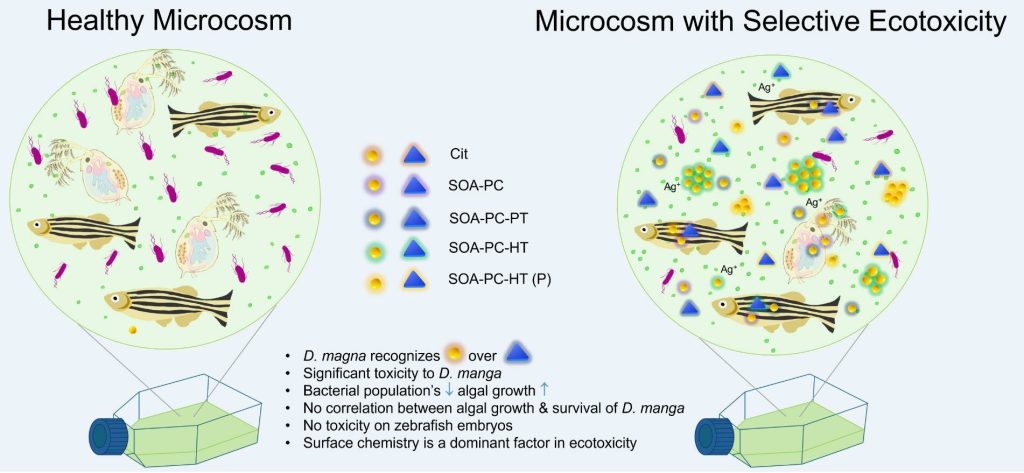Credit: Nanomaterials (2024). DOI: 10.3390/nano14080654
Silver has long been used to thwart the spread of illness and in recent years silver nanoparticles have been incorporated into products ranging from sanitizers, odor-resistant clothes and washing machines to makeup, food packaging and sports equipment.
Nanoparticles are tiny pieces of material ranging in size from one- to 100-billionths of a meter. In addition to their antimicrobial properties, silver nanoparticles are industrially important as catalysts and in electronics applications.
Despite their ubiquity, little is known about their environmental toxicity or how it might be mitigated.
Researchers at Oregon State University have taken a key step toward closing the knowledge gap with a study that indicates the particles’ shape and surface chemistry play key roles in how they affect aquatic ecosystems.
The findings, published in Nanomaterials, are important because they suggest silver nanoparticles can be produced in formats that preserve their beneficial properties while limiting environmentally negative ones.
Scientists led by Marilyn Rampersad Mackiewicz and Stacey L. Harper assessed how spherical and triangular-shaped silver nanoparticles with five different surface chemistries affected their uptake and toxicity in a laboratory microcosm of bacteria, algae, Daphnia and embryonic zebrafish.
Daphnia are tiny crustaceans, and zebrafish are a small freshwater species that go from a cell to a swimming fish in about five days.
Zebrafish are particularly useful for studying the development and genetics of vertebrates, including the effects of environmental contaminants and pharmaceuticals on early embryonic development. They share a remarkable similarity to humans at the molecular, genetic and cellular levels; embryonic zebrafish are of special interest because in addition to developing quickly, they are transparent and can be easily maintained in small amounts of water.
The authors note that hundreds of tons of silver nanoparticles are produced every year for commercial uses, meaning it’s inevitable some will end up in aquatic environments.
“Silver nanoparticles are not regulated by the Food and Drug Administration and not much is known about their toxicity except for the free silver ions that can result from surface oxidation of the nanoparticles,” said Mackiewicz, assistant professor of chemistry. “Free silver ions are known to be toxic and in this paper we found a way to study the toxicity of silver nanoparticles and how they impact the environment irrespective of poisonous silver ions.”
Mackiewicz, Harper and collaborators in the OSU colleges of Science, Engineering and Agricultural Sciences found silver nanoparticles negatively affect some species but not others.
“For example, there is a decrease in bacterial and Daphnia growth, and the size and shape of the particles can contribute to that, but the nanoparticles didn’t affect zebrafish,” she said. “And nanoparticles coated in lipids, organic compounds found in many natural oils and waxes, did not release significant amounts of silver ions—but they exhibited the greatest toxicity to Daphnia magna, the most sensitive species in the microcosm.”
Overall, Mackiewicz said, the study showed that silver nanoparticles’ shape and surface chemistry can be manipulated to achieve specific objectives necessary for better understanding and mitigating the risks associated with silver nanoparticles. A related study awaiting publication, she added, shows that small, spherical nanoparticles are more toxic than triangles or cubes.
Nanoparticles are the latest format, Mackiewicz notes, for an element that throughout history has been used to restrict the spread of human disease via incorporation into items used in everyday life. Its earliest recorded use for therapeutic purposes dates back 3,500 years.
During the Middle Ages, wealthy families used so many silver vessels, plates and other products that they developed bluish skin discolorations known as argyria, a condition believed to have led to the term “blue blood” as a description for members of the aristocracy.
Collaborating with Mackiewicz and Harper on the study were OSU researchers Bryan Harper and Arek Engstrom.
More information: Bryan J. Harper et al, Impacts of Differentially Shaped Silver Nanoparticles with Increasingly Complex Hydrophobic Thiol Surface Coatings in Small-Scale Laboratory Microcosms, Nanomaterials (2024). DOI: 10.3390/nano14080654
Provided by Oregon State University
Citation: Research explores ways to mitigate the environmental toxicity of ubiquitous silver nanoparticles (2024, May 11) retrieved 13 July 2024 from https://phys.org/news/2024-05-explores-ways-mitigate-environmental-toxicity.html
This document is subject to copyright. Apart from any fair dealing for the purpose of private study or research, no part may be reproduced without the written permission. The content is provided for information purposes only.

